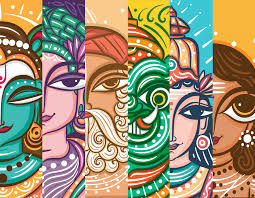
Menu

India’s cultural heritage is deeply enriched by its folk and tribal art traditions. These art forms are not just creative expressions but also a reflection of the daily life, beliefs, and customs of various communities. Unlike classical art, which developed in royal courts and temples, folk and tribal art grew organically within rural and tribal societies, passed down from generation to generation.
These artworks are deeply rooted in tradition and are closely linked to nature, mythology, spirituality, and social customs. Each region in India has its own distinctive styles, themes, and techniques, making this a diverse and vibrant category of Indian art.
Madhubani, also known as Mithila art, originated in the Mithila region of Bihar. Traditionally done by women on the walls and floors of their homes during festivals and rituals, these paintings are now created on canvas and paper. They feature intricate patterns, geometric designs, and symbolic motifs. Common themes include Hindu deities, nature, marriage scenes, and folklore. The use of natural colors and bold outlines gives Madhubani its characteristic look.
Warli art is practiced by the Warli tribe in Maharashtra. These paintings are typically made on the walls of huts using white pigment made from rice paste on a mud background. Warli art is minimalist and uses basic geometric shapes—circles, triangles, and squares—to represent humans, animals, and nature. Scenes of farming, hunting, dancing, and village life are common, expressing harmony with nature and social unity.
Pattachitra, meaning “cloth painting,” is a traditional scroll painting style from Odisha and West Bengal. These artworks are characterized by intricate borders, mythological themes (especially of Lord Jagannath, Krishna, and Vishnu), and vibrant natural colors. Pattachitra artists are known for their storytelling ability, often narrating stories through long scrolls.
Phad is a traditional narrative scroll painting practiced in Rajasthan. It is painted on long pieces of cloth, typically depicting stories of local folk deities like Pabuji or Devnarayan. These scrolls are used by bhopas (folk singers) who travel from village to village, singing the stories while unrolling the scroll. The art form is colorful and highly stylized.
Gond art is created by the Gond tribe of central India. It is a highly decorative style, with vivid colors and repetitive patterns, often used to portray animals, trees, folklore, and daily village life. The unique aspect of Gond painting is the use of fine lines and dots to create a textured appearance. It is both artistic and symbolic, often carrying spiritual meaning.
Folk and tribal art forms are not only artistic expressions but also cultural records of indigenous knowledge, rituals, and oral traditions. They are created using eco-friendly materials like natural dyes, mud, cow dung, and plant-based pigments. With modernization, many of these traditions faced decline, but recent efforts by art organizations, government bodies, and NGOs have helped revive and promote them nationally and internationally.

@THE INDIAN ART COTTAGE
© The Indian Art Cottage | All Rights Reserved | 2025